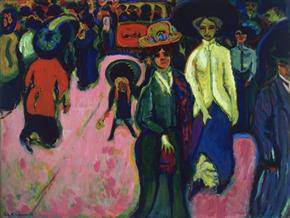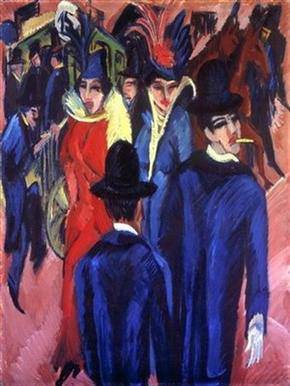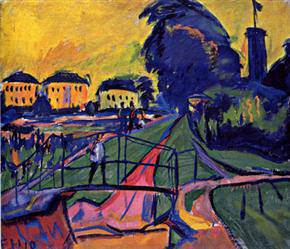
Ernst Ludwig Kirchner (1880-1938)
Street, Dresden, 1908/1919
Oil on canvas, 150.5 x 200.4 cm (59¼ x 78 7/8 in.).
The Museum of Modern Art, New York, Purchase

Ernst Ludwig Kirchner (1880-1938)
Berlin Street Scene, 1913-14
Oil on canvas, 121 cm x 95 cm (47 5/8 x 37 3/8 in.).
Neue Galerie New York and Private Collection, New York

Erich Heckel (1883-1970)
Landscape in Dresden, 1910
Oil in canvas, 66.5 x 78.5 cm (26 1/8 x 30 7/8 in.).
Staatliche Museen zu Berlin, Neue Nationalgalerie
Brücke: The Birth of Expressionism in Dresden and Berlin, 1905-1913 – Neue Galerie
Featuring more than 100 paintings, sculptures, and works on paper, this will be the first major exhibition in the United States to focus on the pioneering artists of the Expressionist group known as the Brücke
February 26 – June 29, 2009
]]>
“It is now over forty-five years since I began collecting these artists,” said Ronald S. Lauder, President of the Neue Galerie, “and their work still envelops me with all the strength and excitement that I felt on first seeing it. It is the essence of German Expressionism.”
“The artists of the Brücke sought to unify art and life,” said Renée Price, Director of the Neue Galerie. “Their approach, and their art, was nothing short of revolutionary.”
On June 7, 1905, four architecture students in Dresden—Fritz Bleyl, Erich Heckel, Ernst Ludwig Kirchner, and Karl Schmidt-Rottluff—founded the artists’ group “Brücke,” or “bridge.” Their chosen name served as an apt metaphor for their ambitions to create a new link between the art of the past and that of the future. Following the stunning early success of the group, the artists Herman Max Pechstein and Otto Mueller joined its roster.
On June 7, 1905, four architecture students in Dresden—Fritz Bleyl, Erich Heckel, Ernst Ludwig Kirchner, and Karl Schmidt-Rottluff—founded the artists’ group “Brücke,” or “bridge.” Their chosen name served as an apt metaphor for their ambitions to create a new link between the art of the past and that of the future. Following the stunning early success of the group, the artists Herman Max Pechstein and Otto Mueller joined its roster.
The Brücke artists forged a signature modern approach. Living in a bohemian communal setting and working in a brisk, direct style, they offered frank depictions of nudes and other studio subjects. Their influences ranged from medieval woodcuts to African and Oceanic art. Today the raw, vibrant presence, blazing color, and striking emotional candor of their art continues to engage viewers. It forms the basis for German Expressionism.
The Brücke artists officially relocated from Dresden to Berlin in 1911, imagining that further artistic growth and increasing critical and financial success awaited them there. Although their depictions of rural life had a lyrical quality, their paintings of Berlin took a more critical approach, and often served as indictments of the frenetic quality of urban life. By 1912, personal rivalries led to the dissolution of the group
Follow us on:

